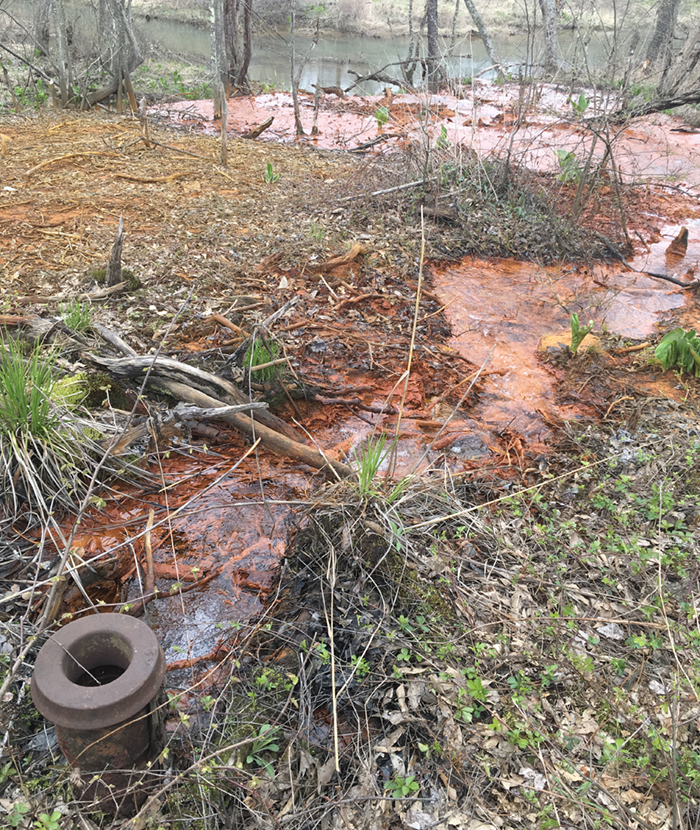
Adam Peltz, director and senior attorney of energy transition at the Environmental Defense Fund. (Terrence Irving Photography/courtesy of EDF)
Adam Peltz, AB’05, is helping combat an environmental scourge.
On a clear Tuesday evening in September, over macaroni salad, blondies, and Yuengling beer, about 20 residents of Titusville, Pennsylvania, described to Adam Peltz, AB’05, the orphaned oil wells on or near their properties.
These abandoned wells can be hard to find. Some of them leak, and a few leak badly. You can tell by the toxic smell and the hissing noise. They emit dirty water into nearby streams, and the plants around their openings are dead.
The Titusville locals had gathered at the site of the historic Drake Well, the first commercial oil well in the United States, to learn about an Environmental Defense Fund (EDF) effort to find and plug orphaned oil wells in their county. Peltz is director and senior attorney of energy transition at EDF, but here in western Pennsylvania, he’s seen as more of a carpetbagger.
“Most of these people have lived in this area for generations,” he says. So when a large nonprofit comes in to look for environmental liabilities—with no guarantee they’ll be fixed—he isn’t surprised that some people are skeptical.
But Peltz draws on heart and humility to bring civil society, government agencies, and industry together to handle abandoned oil wells, here and across the country.
Peltz is an environmental attorney who began his journey as a political science major at UChicago. He initially aimed for a career in international development, but during law school at Boston University he discovered that climate change and global development issues are, as he puts it, “two sides of the same coin.” He was drawn to EDF’s science- and economics-based approach to environmental challenges, and in his 13 years at the nonprofit he’s become a leading voice in addressing the often-overlooked problem of orphaned oil and gas wells.
His work involves understanding the technical aspects of well plugging and also navigating the complex landscape of state regulations and industry interests—all while working toward positive change. But the event in Titusville was, for him, a rare foray into direct community engagement.
Drilled in 1859, the Drake Well sparked a Pennsylvania oil boom that lasted until 1901, when production shifted westward to Texas. Today Pennsylvania is home to about 27,000 known orphaned oil and gas wells—the most of any state. But that is almost certainly a vast undercount: Peltz estimates that the real number in Pennsylvania could be as high as 700,000. In fact, about 14 million Americans live within one mile of a documented orphaned well.
Oil and gas production began in western Pennsylvania in the 1850s, and for the next 100 years “there was basically unregulated drilling,” Peltz says. “Standard Oil was punching one hole after the other after the other.”
For decades, when a well stopped producing, it was simply left behind with no paper trail. In the 1950s states started to get more serious about regulating well plugging, but it wasn’t until the 1970s that companies were required to provide financial guarantees to cover plugging costs if they went bankrupt—although Peltz says enforcement has been spotty at best.

Over time abandoned wells break down, releasing radioactive and carcinogenic chemicals. Methane, for example, is not only a potent greenhouse gas but also a major safety hazard when trapped in small spaces.
If you have an undocumented well emitting methane under your house, “it can go into your basement and explode,” says Peltz. “That does happen.”
Plugging a well requires pouring cement down the shaft and using cast-iron bridge plugs to hold the cement in place, at an average cost of $50,000 to $75,000 per well. Multiply this by Peltz’s estimate of about a million abandoned wells across the United States, and the cost is astronomical.
Working with state governments and the oil industry, Peltz and EDF brought together Democrats and Republicans to develop a package within the 2021 infrastructure law earmarking $4.7 billion for mitigation of orphaned wells—a small win, since he estimates this funding to be only about 5 percent of what’s currently needed. Still, he says, “one of the benefits of getting this funding in place is that we are now in fact having conversations about this issue.”
Having a national perspective is one reason EDF is well positioned to tackle the orphaned well problem, Peltz says. For example, EDF’s analyses of different approaches across states can aid decision-making about well mitigation.
Showing up to one state with empirical data that points to tangible results can really make a difference, he says: “We can say, ‘Hey, New Mexico, … here’s what Utah has done, and maybe you could do it. And in fact, we’re going to take your well data set, and we’re going to apply the Utah rule and show you how much money you’d be getting.’”
As of late 2024, $1 billion of the $4.7 billion national earmark had been spent, and 10,000 wells had been plugged. The rest of the funding will come in installments when states achieve benchmarks like plugging the highest-risk wells and enacting measures to ensure new wells will be overseen until the end of their lives.
In Titusville, and at events in neighboring Clarion and McKean Counties, Peltz tells residents that the roughly $101 million their state has received so far won’t cover plugging its documented wells, let alone the undocumented ones.
And the only way to get more funding is to go out and find more orphaned wells.
To help in that effort, EDF and the Pennsylvania Department of Environmental Protection have begun piloting drones equipped with magnetometers and methane sensors. The first outing revealed several probable and possible wells in just one small area.
Armed with these maps and the inroads he’s making with local people, Peltz is hopeful this work can come into the spotlight and eventually expand to the rest of the country.
“People know this is an issue,” he says. “There just hasn’t been any empowerment to deal with it. And what we’d like to do is bring some empowerment.”
